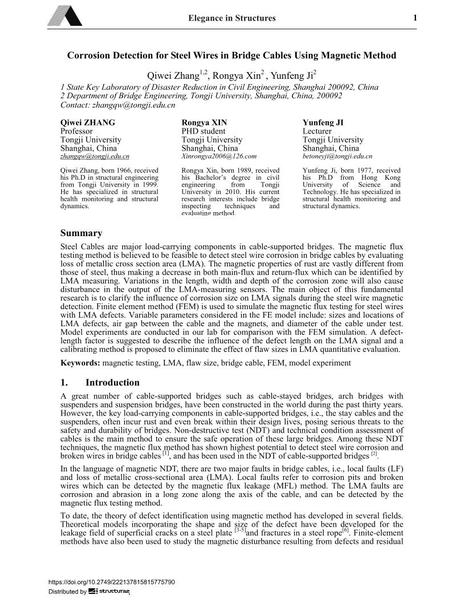Corrosion Detection for Steel Wires in Bridge Cables Using Magnetic Method

|
|
|||||||||||
Bibliografische Angaben
| Autor(en): |
Qiwei Zhang
Rongya Xin Yunfeng Ji |
||||
|---|---|---|---|---|---|
| Medium: | Tagungsbeitrag | ||||
| Sprache(n): | Englisch | ||||
| Tagung: | IABSE Conference: Elegance in structures, Nara, Japan, 13-15 May 2015 | ||||
| Veröffentlicht in: | IABSE Conference Nara 2015 | ||||
|
|||||
| Seite(n): | 440-441 | ||||
| Anzahl der Seiten (im PDF): | 8 | ||||
| Jahr: | 2015 | ||||
| DOI: | 10.2749/222137815815775790 | ||||
| Abstrakt: |
Steel Cables are major load-carrying components in cable-supported bridges. The magnetic flux testing method is believed to be feasible to detect steel wire corrosion in bridge cables by evaluating loss of metallic cross section area (LMA). The magnetic properties of rust are vastly different from those of steel, thus making a decrease in both main-flux and return-flux which can be identified by LMA measuring. Variations in the length, width and depth of the corrosion zone will also cause disturbance in the output of the LMA-measuring sensors. The main object of this fundamental research is to clarify the influence of corrosion size on LMA signals during the steel wire magnetic detection. Finite element method (FEM) is used to simulate the magnetic flux testing for steel wires with LMA defects. Variable parameters considered in the FE model include sizes and locations of LMA defects, air gap between the cable and the magnets, and diameter of the cable under test. Model experiments are conducted in our lab for comparison with the FEM simulation. A defect- length factor is suggested to describe the influence of the defect length on the LMA signal and a calibrating method is proposed to eliminate the effect of flaw sizes in LMA quantitative evaluation. |
||||
| Stichwörter: |
FEM
|
||||
